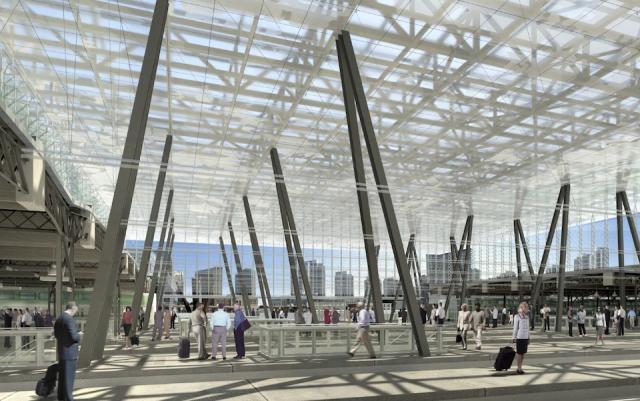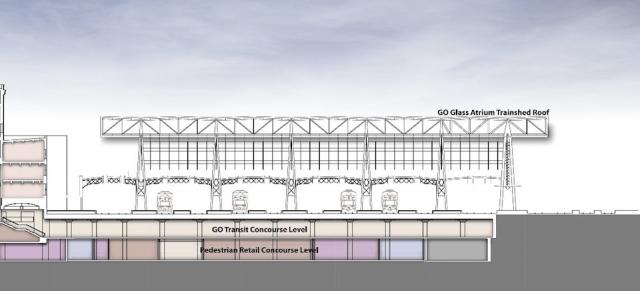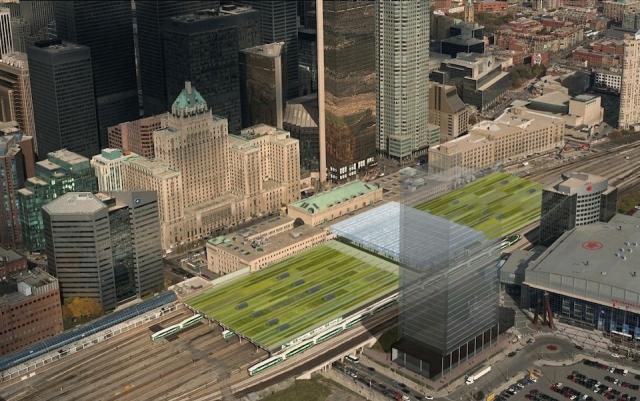This is the first in a series of CityRail In Depth articles, which explore detailed aspects of the CityRail concept and rail service in the Greater Toronto Area. This article is shared with Urban Toronto.
Union Station is the critical point on any regional rail system in Toronto. All corridors funnel through Union, and its location ensures that it will remain by far the busiest station for the foreseeable future. While the beauty of its Great Hall is enduring, if tarnished, the 'business end' of the station—the actual tracks and platforms—was built in 1927 for a very different set of operating practices from modern regional rail.
Union Station is currently undergoing a major renovation project. Passengers will see big changes when it is complete, including the addition of a whole floor of shopping under the station. The main improvement to rail service is the long-overdue addition of many more stairways to the platforms, including a new west side York Street concourse in parallel to the current GO concourse at Bay Street to the east side.
 |
| Union Station Revitalization Section, image courtesy of the City of Toronto |
The original station included few platform access points: two staircases from the current VIA departures concourse and another pair from the parallel exit concourses. The GO concourse was added to provide several more stair access points to some tracks. The platforms themselves are low, unlike Montreal Central Station, Penn Station in New York, or virtually all stations in Europe; this means that passengers must climb steps to reach the car level, which dramatically increases the time required to board and unload trains and makes boarding much more difficult for passengers in wheelchairs. The renovation project will solve most of the problems of limited platform access and poor station circulation, but it will do nothing to improve the problems related to platform width and height.
The Union Station rail corridor has also recently been rebuilt, more-or-less to its original 1927 layout, with the addition of a fly-under to the west of the station. Trains are forced to slow down as they go through many switches. Awkward operating practices compound the problem: running the Airport Rail Link to platform track 1 will force it to cross many other lines at grade, reducing capacity and reliability on all routes. GO Trains dwell for a very long time at the station compared to most international railways, which is the main limitation on capacity. The major causes are the large size of the trains coupled with the relatively few doors per car, which means trains take a long time to load and unload. This is compounded by the low platforms, narrow platforms, and relatively few access points. Most international regional rail systems runthrough trains, which means that they don’t occupy valuable space at the busiest station in the system as they carry out the procedures required to turn the train. These procedures are also much more onerous in North America than in Europe, including the requirement for a time consuming brake test every time the train is turned.
 |
| Union Station Glass Atrium and Bush Shed Renovation, image courtesy of GO Transit |
Current Planning
Metrolinx explored these capacity issues in the recent Union 2031 study (helpfully provided by Steve Munro’s blog). It examines a number of scenarios and possible changes to the station to enhance its capacity. While it is admirable that Metrolinx is looking to the future, it is unfortunate that the study wasn’t conducted before the current revitalization project began. That would have allowed the project to incorporate more improvements to train operations, in addition to aesthetic and commercial upgrades. While useful, the study includes some very questionable assumptions. Foremost among them is the establishment of five minutes as the absolute minimum dwell time possible, even for a through train (turning trains would require ten minutes). There is no explanation of how this was derived, and it is far higher than standard international practice, where trains dwell at stations far busier than Union for times consistently measured in seconds. This assumption colours the entire study and makes the station appear far more constrained than it is by international standards. As an extreme comparison, it handles about 200,000 passengers per day on 15 tracks, while Tokyo’s Shinjuku JR Station handles over 1.5 million per day on 14 tracks. Paris’ Châtelet-Les Halles station on the RER handles half a million riders per day on only seven tracks.
In the short-to-medium term, the Metrolinx study reasonably deems the current arrangement acceptable once platform access improvements are complete. In the much longer term, it looks at several major capital expenditures that would provide an additional pair of tracks underground, but that’s a costly project when Union is nowhere near international standards of capacity. An even madder scheme would dead-end Georgetown and Milton lines at Bathurst North, destroying the possibility of an interconnected regional rail system once and for all. Other cities, like Paris, Munich, and London, have spent or are spending billions to correct the mistake of separate stations on regional rail routes. It would be a truly baffling step backwards for Toronto to go in the other direction. Fortunately, despite the press that such schemes have received, Metrolinx doesn’t believe that any of these changes will be required any time soon.
 |
| Union Station Revitalization, Shed and Atrium Section, image courtesy of the City of Toronto |
Potential Solutions
There are several options for modifying Union’s platform arrangement to enhance capacity.
The international standard is for platforms that are far wider than those at Union. It could be possible to create reasonably wide platforms by shifting the tracks into the space now occupied by the baggage platform. While a seemingly simple solution, it runs into difficulty as columns currently run from directly beneath the current tracks down to bedrock. The tracks cannot simply be moved without finding new ways to support the weight of trains. Shifting the columns would have been a very good idea, given that builders are already in the process of digging out the entire underside of the station, including completely removing and rebuilding the columns. Unfortunately such a plan was not included in a retail- rather than transportation-focused Union revitalization.
 |
| Union Station Revitalization Column Replacement, image courtesy of the City of Toronto |
There may be other options for shifting the tracks while keeping the columns in their present position. For example, steel beams could run beneath the tracks, connecting the columns and carrying the weight of trains onto the adjacent two columns. Chicago has recently developed a capacity enhancement strategy for its own Union Station. It has a very similar platform arrangement to Toronto’s Union, and its planners propose widening its passenger platforms by eliminating the baggage platforms. If a new means of supporting the tracks is possible, this is the simplest solution and would produce standard island platforms of reasonable width.
An even bolder option for CityRail would involve the removal of tracks (numbered from the North) 2, 3, 5 and 7. This would provide four tracks and extremely wide platforms in a “Spanish Solution.” Though the number of platform tracks used by CityRail would be reduced, the arrangement would be comparable to stations like Chatelet-Les Halles in Paris, which moves far more passengers than Union in a CityRail-type of system. A new, detailed circulation study of these options would be necessary to determine which would provide the highest passenger throughput and closest headways. It needs to be done on the basis of international standards, without including strange assumptions like the five-minute minimum dwell time.Issues of corridor and track capacity will be examined further in an upcoming CityRail In Depth article.
Any real improvement to the platform and track arrangement at Union would likely require the removal of the Bush trainshed, which is the roof covering the track area. The central portion is currently being removed and replaced with a high glass roof, while the remainder is being preserved as a heritage structure. The Bush design was a fairly common and utilitarian approach to covering tracks that was popular in the pre-war period. It has historic significance, but it is far from the last of its kind. The Bush shed makes it difficult to change the track arrangement, raise platforms to the level of train doors, and accommodate overhead catenary for electrification. It also creates a dank and uncomfortable setting for passengers to wait for their trains. Union Station is a very important piece of transportation infrastructure in the GTA It may be necessary to sacrifice the trainshed, just as it was necessary to sacrifice the architecturally significant Terminal One in order to modernize and expand Pearson Airport. Unlike Terminal One, it should be feasible to dismantle the trainshed and move it to another location in the city, where it could be repurposed into something like the Wychwood Art Barns.
 |
| Union Station Revitalization Bush Shed Green Roof and Glass Atrium, image courtesy of GO Transit |
Union Station is the linchpin of any regional rail system in the Greater Toronto Area. CityRail requires a reasonable track and platform arrangement at Union in order to function reliably and offer high capacity. There are many options to improve the station without the need for drastic measures like separate underground platforms, so Union should be able to function well as the hub of CityRail for the foreseeable future without a total rebuild.
"the platforms are low ... this means that passengers must climb steps to reach the car level"
ReplyDeleteOnly for VIA trains. GO Transit trains are basically level boarding, and they account for ~95% of all passengers at the station.
"Trains are forced to slow down as they go through many switches."
ReplyDeleteThe current switch replacement project fixes that.
"Awkward operating practices compound the problem: running the Airport Rail Link to platform 1 will force it to cross many other lines at grade".
Umm, no... you mean platform 3 (there is no platform 1 or 2), and it will at worst have to cross only the Georgetown line tracks.
"[GO Transit] trains take a long time to load and unload". They take under a minute to load or unload. The limitation on capacity is the time between a train leaving and one arriving at the same platform, which is a function of the signalling.
"... as they carry out the procedures required to turn the train" GO's Trains aren't generally truend at Union - they run through to the yards located west and east of the station.
The trainshed is deemed historic, and I believe it is one of the last of its kind in Canada.
The cheapest way to increase the number of trains in and out of Union would be for VIA to allow passengers on platforms before its trains arrives (reducing boarding time), and for its trains to go to the yards either side of Union immediately after unloading (and vice versa for trips starting at Union). Currently their trains sit on the platforms for far too long.
The GO platforms are most definitely not level boarding, and wouldn't not be considered level by any reasonable transit operator. It requires two steps to reach the trains, which slows able-bodied passengers and is impossible for people in wheelchairs. If it requires a special boarding area and a connecting bridge for wheelchairs to board, it's not level. The Toronto subway platforms, for example, are actual level boarding, as is every international application of real regional rail.
ReplyDeleteThe switch replacement project makes it better, but trains will certainly not be able to run at full speed through the interlocking, which is a must for regional rail operation.
When I say platform 1, I'm using the conventional method of numbering tracks, instead of GO's confusing system. You're right that I should have referred to track 1 instead of platform 1! It will also have to cross Barrie, Bolton (when it starts), and possibly Milton.
If you read Metrolinx's report, it claims that trains require a minimum dwell time of five minutes even for through trains. This is because of the need to load and unload trains, as well as clear the platforms of people. If signalling is actually requiring five minute spacing, then we need a new signalling system, which was a key part of the CityRail proposal.
The shed was deemed historic, but so was Terminal One at Pearson. It's also one of the last in Canada (Winnipeg has a fully intact one too), but there's a world outside our borders. Moreover, it's already being compromised by being cut in half and having a glass roof installed. There are plenty of Bush examples in the U.S. In an ideal world, the trainshed could be preserved (though it doesn't provide an ideal waiting environment for passengers), but not at to the detriment of operations at a piece of infrastructure as important as Union Station. It could almost certainly be rebuilt and repurposed at another location.
I completely agree about VIA, and as its number of dedicated platforms is gradually reduced, such changes will become increasingly necessary. Forcing people to crowd and line up in the concourse doesn't make much sense at all. That still won't solve the issues that need to be solved before we real regional rail can be operated through Union.
The two steps are so small that they may as well be one step, and they don't seem to slow able-bodied passengers. When you say "non-level boarding", people think of a climb of VIA-like proportions. I agree it prevents wheelchair users.
Delete"... as is every international application of real regional rail". No regional rail in the UK is level boarding (see http://en.wikipedia.org/wiki/File:Greater_Western_Franchise_Bidders.jpg ), neither is Paris's RER by your definition (see http://en.wikipedia.org/wiki/File:Z5300_IMG_8350.jpg ) ... and those are just the first two I checked.
I read Metrolinx's report, and their minimum dwell time is excessive and doesn't match reality. When trains have been late, I've seen them unload and reload and be underway in the under three minutes.
On signalling, the CityRail proposal seemed to be talking about PTC-style signaling, which is not needed. The current signalling system needs shorter block sections (basically so the next train at the platform is more or less waiting outside when the previous one departs).
It's an awkward way to board trains and it's definitely not ideal. No greenfield regional system is built with non-level platforms.
DeleteUnder three minutes is still far, far from good enough. Imagine if the subway needed to dwell at stations for three minutes.
PTC-style signalling, in particular the international standard ERTMS, may not be necessary right away, but it will be necessary for some corridors when inevitable growth occurs. We should install the most modern standard of signalling possible right away, rather than installing an obsolete system and then needing to replace it a few decades down the line. More on these issues in a future post.
It should be viable to raise the platform level to the "low boarding" level of the bilevels without demolishing the train shed.
ReplyDeleteThe unfortunate part is that the elevators and staircases need to be designed to arrive at the new, higher height, which should have been done during planning. :-P
The proposal to simply knock out some tracks and fill them in with platform is the most effective way to widen the platforms. This will only work if *through-running* is done. Through-running could be done *NOW*. Through-running IS done on the Lakeshore Line.
As for VIA, its procedures are archaic, its rolling stock is archaic, and every single government seems to have been determined to crush it. If it ever gets new rolling stock, it can get low-floor trains; something can be done about the Montreal Central and Quebec platforms.
That's a very good point about the elevators and staircases, which is why I wish the Union Station reconstruction project had been designed with a future CityRail-type system in mind. At the very least, the idea of raising platforms should have been taken into account and the platform capacity study should have been completed before the station improvements were designed. That said, modern regional rail rolling stock has a considerably higher floor level than the GO bilevels, so I'd rather see the platforms raised to their level. Having low floors on trains brings considerable technical, operational, and financial costs. It's a lot better to just build higher platforms.
DeleteYou're also absolutely right about through-running, and it is indeed done on the Lakeshore line, but with a painful, capacity-killing, and ultimately unnecessary long pause at Union. All lines should be through-run, with staff changes and any other delaying procedures carried out at the terminal stations. It makes no sense to use scarce platform capacity occupying the most expensive real estate in the city when it can be done at terminal stations where there's loads of space.